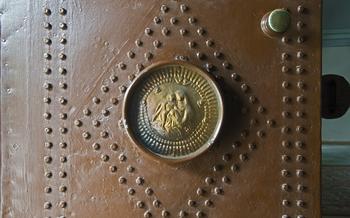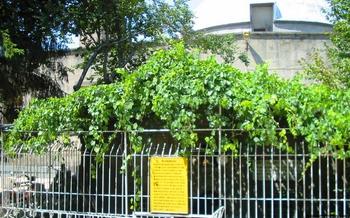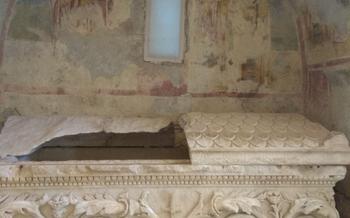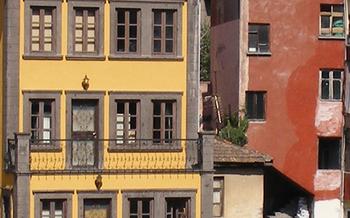
Germir Church
- A Journey Through History: Unveiling Germir Church's Rich Past
- Location and Accessibility: A Hidden Gem in Kayseri's Heart
- Step Inside: Exploring the Church's Interior
- A Place of Worship: Experiencing Religious Ceremonies
- Preservation and Restoration: Protecting a Cultural Treasure
- Beyond the Walls: Exploring the Church's Surroundings
- A Place of Reflection and Serenity: Finding Inner Peace
- A Glimpse into Local Traditions: Festivals and Events
- The People of Germir: Guardians of a Legacy
- Educational Programs and Workshops: Sharing Knowledge
- A Haven for History Buffs and Architecture Enthusiasts
- Germir Church in Literature and Art: Inspiration and Expression
- Literature
- Painting
- Music
- Film
- Accessibility for All: Ensuring Inclusivity
- Insider Tip: Hidden Gems and Secret Spots
A Journey Through History: Unveiling Germir Church's Rich Past
Deep within the heart of Kayseri, Turkey, lies a hidden gem that whispers tales of a bygone era – the Germir Church. Its history is as rich and intricate as the Byzantine mosaics that adorn its walls, taking visitors on a journey through time, faith, and architectural brilliance.
Constructed in the 11th century, the Germir Church stands as a testament to the architectural prowess of its time. Its unique blend of Byzantine and Armenian influences creates a captivating fusion of styles, making it a masterpiece of medieval architecture. Its sturdy stone walls and intricate carvings have withstood the test of time, preserving the essence of a glorious past.
Beyond its architectural significance, the Germir Church holds immense religious importance. Originally built as a place of worship for the Armenian community, it later served as a Greek Orthodox church, showcasing the diverse religious heritage of the region. The church's interior is adorned with beautiful frescoes and iconography, each brushstroke narrating stories of faith, devotion, and the divine.
The Germir Church's existence is deeply intertwined with the cultural identity of Kayseri. It serves as a reminder of the city's rich Christian history and its role as a crossroads of civilizations. The church's enduring presence speaks volumes about the tolerance and coexistence that have shaped Kayseri's tapestry of cultures.
Location and Accessibility: A Hidden Gem in Kayseri's Heart
Germir Church, nestled in the heart of Kayseri, is a hidden gem waiting to be discovered. To reach this architectural marvel, visitors can embark on a scenic journey through the city's vibrant streets, immersing themselves in the local culture. The church is conveniently located in the historic center of Kayseri, within walking distance of many other notable landmarks.
For those arriving by public transportation, several bus lines offer convenient access to the area. Visitors can hop off at the "Germir Kilisesi" stop and follow the signs or ask for directions from friendly locals.
Once in the vicinity of the church, take a moment to admire the surrounding neighborhood, with its charming cobblestone streets and traditional Turkish architecture. Before entering the church, be sure to explore the nearby Kayseri Castle, a magnificent fortress that offers stunning panoramic views of the city.
To avoid crowds, plan your visit during the off-season or on a weekday. This will allow you to fully appreciate the church's tranquility and immerse yourself in its rich history without distractions.
Step Inside: Exploring the Church's Interior
As you cross the threshold of Germir Church, prepare to be captivated by its awe-inspiring interior. The church's layout is a testament to its rich history, featuring a central nave flanked by two aisles. The nave is adorned with a series of magnificent arches, supported by intricate columns that reach towards the heavens. The arches create a sense of spaciousness and grandeur, inviting you to explore the church's hidden corners.
Your gaze will be drawn to the intricate iconography adorning the walls and ceilings. These exquisite paintings and mosaics depict scenes from the Bible, narrating the stories of saints and martyrs with vivid detail. The vibrant colors and expressive brushstrokes bring the biblical tales to life, creating a sense of connection between the earthly and the divine.
Take a moment to admire the finely carved wooden pulpit, a masterpiece of craftsmanship that stands as a symbol of the church's authority. Its intricate carvings depict biblical scenes, adding another layer of storytelling to the church's interior.
The altar, the focal point of the church, exudes an aura of reverence. Its elaborate design and ornate decorations speak to the sacred nature of this space. Intricate carvings, shimmering gold leaf, and colorful gemstones adorn the altar, creating a sense of awe and wonder.
A Place of Worship: Experiencing Religious Ceremonies
The Germir Church remains an active place of worship for the local Christian community. Visitors are welcome to attend religious ceremonies and services, which offer a unique opportunity to experience the church's spiritual significance firsthand.
The church regularly holds masses, baptisms, and other ceremonies throughout the year. While attending a religious ceremony, it is important to be respectful of the ongoing service and observe proper etiquette. Dress modestly and avoid disruptive behavior or loud noises.
For visitors who wish to participate in a ceremony, it is advisable to arrive early to secure a seat. It is also customary to make a small donation to the church to support its upkeep and maintenance.
Attending a religious ceremony at the Germir Church can be a deeply moving and enriching experience. It allows visitors to witness the church's living legacy as a place of faith and devotion, and to connect with the local community on a deeper level.
Preservation and Restoration: Protecting a Cultural Treasure
The Germir Church stands as a testament to the enduring spirit of Kayseri's cultural heritage. Recognizing its immense value, significant efforts have been undertaken to preserve and restore the church's original features, ensuring its legacy endures for generations to come.
Preservation work has focused on safeguarding the church's architectural integrity, using traditional techniques and materials to restore its intricate details. This delicate process requires skilled artisans and craftsmen who possess a deep understanding of the church's history and construction.
Challenges in maintaining the church's integrity are not insignificant. The passage of time, natural elements, and human intervention have all taken their toll on the structure. Balancing the need for preservation with the demands of modern accessibility and safety regulations presents a delicate balancing act.
Local communities and organizations play a crucial role in safeguarding this cultural treasure. They serve as advocates, raising awareness of the church's importance and mobilizing resources for its preservation. Their dedication has been instrumental in securing funding, expertise, and volunteers to support restoration efforts.
Success stories abound, demonstrating the transformative power of preservation. The restoration of the church's iconic dome, once in danger of collapse, stands as a testament to the dedication of skilled craftsmen and the generosity of donors.
The ongoing preservation of Germir Church is a testament to the enduring power of cultural heritage. It serves as a reminder that preserving our past ensures a vibrant future, where generations to come can continue to marvel at this architectural masterpiece.
Beyond the Walls: Exploring the Church's Surroundings
Stepping outside the Germir Church, visitors are greeted by a vibrant neighborhood that seamlessly blends history with modern life. The surrounding area is a treasure trove of hidden gems, inviting you to delve deeper into the cultural tapestry of Kayseri.
Wander through the narrow cobblestone streets, lined with charming shops selling traditional Turkish handicrafts, carpets, and souvenirs. Discover local artisans at work, creating intricate pottery, jewelry, or textiles that showcase the region's rich craftsmanship.
For a culinary adventure, savor the authentic flavors of Turkish cuisine at nearby restaurants. Indulge in mouthwatering kebabs, succulent mezes, and freshly baked pastries, all prepared with love and local ingredients. Don't miss the opportunity to sip on aromatic Turkish coffee or tea in a traditional teahouse, immersing yourself in the local way of life.
Explore the neighboring attractions that complement your visit to the Germir Church. The Kayseri Castle, with its imposing walls and towers, stands as a testament to the city's rich history. Delve into the fascinating exhibits at the Kayseri Archaeological Museum, showcasing artifacts from various civilizations that have shaped the region.
Capture the essence of your visit through photography. The picturesque streets, colorful shops, and architectural wonders provide endless opportunities to capture stunning images. Embrace the beauty of the Germir Church from different angles, experimenting with different lighting conditions to create unique and memorable photographs.
A Place of Reflection and Serenity: Finding Inner Peace
Germir Church stands as a sanctuary inviting visitors to transcend the realm of the mundane and embark on a journey of introspection. Within its hallowed walls, an atmosphere of tranquility prevails, beckoning individuals seeking solace, inspiration, and a profound connection with their inner selves.
The church's serene ambiance envelops visitors, inviting them to shed the weight of worldly concerns and immerse themselves in a realm of contemplation. The gentle play of light filtering through the stained-glass windows casts ethereal patterns upon the ancient stone, creating a mystical aura that fosters a sense of awe and reverence.
Throughout the centuries, countless souls have sought refuge within Germir Church's embrace, finding solace in its sacred space. Stories abound of individuals who, burdened by life's trials, discovered renewal and strength within the church's walls. Some found comfort in the flickering flames of votive candles, while others found solace in the hushed whispers of prayer echoing through the centuries.
To fully appreciate the church's transformative power, it is essential to approach it with an open heart and a willingness to let go of distractions. Whether seeking solace from personal struggles, yearning for spiritual guidance, or simply desiring a moment of quiet reflection, Germir Church offers a sanctuary for all who seek inner peace and a deeper connection to their spiritual selves.
A Glimpse into Local Traditions: Festivals and Events
The Germir Church, deeply embedded in the cultural fabric of Kayseri, serves as a stage for traditional festivals and events that showcase the city's rich heritage. One of the most notable celebrations is the annual Germir Festival, a vibrant display of local traditions, music, and dance. Held during the summer months, the festival transforms the church's surroundings into a lively hub of cultural expression. Visitors can immerse themselves in folk performances, savor delicious Turkish cuisine, and witness the infectious energy of traditional dances.
Another significant event is the Feast of Saint George, a religious holiday honoring the patron saint of the church. During this time, the church becomes a focal point of spiritual devotion and community gatherings. Pilgrims from near and far flock to participate in special masses, processions, and candlelit ceremonies. The atmosphere is one of reverence, unity, and a deep connection to the church's history and traditions.
For those seeking a truly immersive experience, attending these festivals and events is a must. They offer a rare glimpse into the vibrant tapestry of local customs, allowing visitors to connect with the heart and soul of Kayseri's cultural identity.
The People of Germir: Guardians of a Legacy
The Germir Church stands as a testament to the enduring spirit of the local community. Throughout its history, generations of Kayseri residents have played a crucial role in preserving and protecting this sacred site. From humble beginnings, the church has grown into a symbol of resilience and cultural identity, thanks to the unwavering efforts of the local people.
Among the many individuals who have dedicated their lives to the church's preservation is Mehmet Bey, a retired history teacher who has spent decades researching and documenting its rich past. His passion for the church's history inspired him to create a small museum within the church grounds, where visitors can learn about its significance and admire artifacts from different eras.
Another key figure in the church's preservation is Ayşe Hanım, a local artist who leads workshops on traditional crafts and techniques used in the church's construction. Through her work, she hopes to pass on these skills to future generations and ensure that the church's unique heritage continues to thrive.
The local community's dedication to the Germir Church goes beyond preservation efforts. On special occasions, the church becomes a gathering place for celebrations, festivals, and religious ceremonies. These events bring together people from all walks of life, fostering a sense of unity and belonging within the community.
Whether it's through their tireless efforts to preserve the church's physical structure, their commitment to passing on its cultural heritage, or their active participation in religious and community events, the people of Germir have proven themselves to be the true guardians of this remarkable legacy. Their unwavering dedication has ensured that the Germir Church remains a beacon of history, faith, and cultural pride for generations to come.
Educational Programs and Workshops: Sharing Knowledge
Germir Church is not just a place of worship and historical significance; it also serves as a hub for cultural awareness and education. Throughout the year, the church organizes various educational programs and workshops that delve into the rich history, architecture, and symbolism of the site. These programs are designed to cater to diverse audiences, including students, history enthusiasts, and anyone seeking to deepen their understanding of this remarkable monument.
One of the most popular programs is the "History of Germir Church" workshop, which takes participants on a journey through time, exploring the church's origins, architectural evolution, and its role in shaping Kayseri's cultural identity. Participants have the opportunity to examine historical documents, artifacts, and replicas, gaining a firsthand glimpse into the past.
For those interested in the intricate details of the church's architecture, the "Architectural Masterpieces of Germir Church" workshop provides an in-depth analysis of the building's design, construction techniques, and unique features. Participants learn about the symbolism behind the church's layout, its decorative elements, and the influence of different architectural styles throughout history.
The church also hosts regular workshops on iconography and symbolism. These workshops explore the profound meanings embedded in the church's artwork, mosaics, and iconography. Participants learn to decipher the symbolism of various motifs, gestures, and colors, gaining a deeper appreciation for the church's spiritual significance.
By participating in these educational programs and workshops, visitors can not only gain a deeper understanding of Germir Church but also contribute to the preservation and promotion of its rich cultural heritage. These programs provide a unique opportunity to engage with experts, fellow enthusiasts, and the local community, fostering a sense of connection and appreciation for this extraordinary site.
A Haven for History Buffs and Architecture Enthusiasts
Germir Church stands as a testament to the rich history and architectural prowess of Kayseri. Its unique features, such as the blend of Armenian and Byzantine architectural elements, make it a must-visit for history buffs and architecture enthusiasts. Visitors can marvel at the intricate stone carvings, admire the soaring arches, and explore the hidden nooks and crannies of the church.
Historical Context:
Built in the 11th century during the Armenian Kingdom of Cilicia, Germir Church bears witness to the region's diverse cultural heritage. Over the centuries, it has undergone various renovations and additions, reflecting the changing political and religious landscape of Kayseri.
Architectural Significance:
The church's architectural style is a harmonious blend of Armenian and Byzantine influences. Its cruciform plan, with a central dome and four arms, is a classic feature of Armenian architecture. The exterior is adorned with intricate stone carvings depicting biblical scenes and geometric patterns, showcasing the skill and artistry of its builders.
Self-Guided Exploration:
For those who prefer a more independent experience, self-guided exploration is a great option. Visitors can wander at their own pace, taking in the details of the church's architecture, admiring the iconography, and soaking up the serene atmosphere.
Capture the Essence:
Photography enthusiasts will find Germir Church a treasure trove of opportunities. The play of light and shadow on the stone carvings, the vibrant colors of the interior, and the picturesque surroundings make for stunning photographs. Capture the essence of the church's history and architecture through your lens.
Germir Church in Literature and Art: Inspiration and Expression
Germir Church has served as a muse for creative minds throughout history, inspiring literary works, paintings, and other artistic expressions.
Literature
- Turkish author Orhan Pamuk's novel "Snow" features a scene set in the Germir Church, where the protagonist reflects on the church's history and its significance to the city of Kayseri.
Painting
- Numerous Turkish painters have captured the beauty and grandeur of the Germir Church in their works. Notable examples include Ibrahim Calli's "Germir Church at Sunset" and Ali Riza Bey's "The Interior of the Germir Church."
Music
- The church's unique acoustics have made it a popular venue for concerts and musical performances. Composers have also drawn inspiration from the church's history and architecture, creating pieces that evoke its spiritual and cultural significance.
Film
- Several Turkish films have featured the Germir Church as a backdrop, including the historical drama "Kayseri 1915" and the romantic comedy "Aşk Kapıda." These films showcase the church's visual appeal and its importance to the city's identity.
These artistic representations not only celebrate the beauty and historical significance of the Germir Church but also contribute to its legacy as a cultural and spiritual landmark.
Accessibility for All: Ensuring Inclusivity
The Germir Church is committed to providing an inviting and accessible environment for visitors of all abilities. Thoughtful measures have been taken to ensure that individuals with disabilities can fully experience the church's historical and cultural significance. Wheelchair ramps and elevators have been installed to facilitate easy access to different areas of the church, including the interior and exterior grounds. Additionally, designated parking spaces are available for visitors with disabilities, ensuring a convenient and stress-free visit. By creating an inclusive environment, the Germir Church demonstrates its dedication to welcoming and accommodating all visitors, regardless of their physical limitations.
Insider Tip: Hidden Gems and Secret Spots
Beyond the main attractions and well-known areas of the Germir Church, there are hidden gems and secret spots waiting to be discovered by curious explorers. One such hidden gem is a small, secluded garden located behind the church's apse. This tranquil oasis features a variety of colorful flowers, aromatic herbs, and fruit trees, creating a peaceful and serene atmosphere. Visitors can take a moment to relax and soak in the beauty of nature, while enjoying the tranquility of this hidden retreat.
Another secret spot worth seeking out is the church's bell tower. While it is not usually open to the public, visitors can sometimes arrange a special tour to climb to the top. The climb offers breathtaking views of the surrounding landscape, including the city of Kayseri, the Erciyes Mountain, and the distant peaks of the Taurus Mountains. For those who dare to make the ascent, the reward is a truly unforgettable experience.









